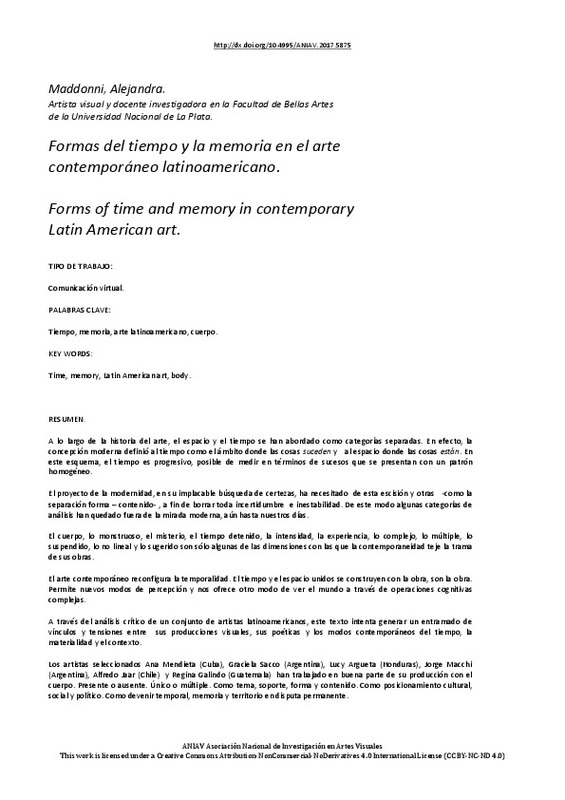JavaScript is disabled for your browser. Some features of this site may not work without it.
Buscar en RiuNet
Listar
Mi cuenta
Estadísticas
Ayuda RiuNet
Admin. UPV
Formas del tiempo y la memoria en el arte contemporáneo latinoamericano
Mostrar el registro sencillo del ítem
Ficheros en el ítem
| dc.contributor.author | Maddonni, Alejandra
|
es_ES |
| dc.date.accessioned | 2018-09-18T08:41:39Z | |
| dc.date.available | 2018-09-18T08:41:39Z | |
| dc.date.issued | 2017-10-23 | |
| dc.identifier.isbn | 9788490485736 | |
| dc.identifier.uri | http://hdl.handle.net/10251/107601 | |
| dc.description.abstract | [EN] Throughout the history of art, space and time have been approached as separate categories. In effect, the modern conception defined time as the domain where things happen and the space where things are. In this scheme, time is progressive, measurable in terms of events that occur with a homogeneous pattern. The project of modernity, in its relentless search for certainties, has needed this split and others as form-content separation order to erase all uncertainty and instability. In this way some categories of analysis have been left out of the modern gaze, even to this day. The body, the monstrous, the mystery, the time stopped, the intensity, the experience, the complex, the multiple, the suspended, the nonlinear and the suggested are just some of the dimensions with which contemporaneity weaves the plot of its works. Contemporary art reconfigures temporality. Time and space are united with the work, they are the work. It allows new modes of perception and offers us another way of seeing the world cognitive operations. Through the critical analysis of a group of Latin American artists, this text tries to generate a network of links and tensions between their visual productions, their poetics and the contemporary modes of time, materiality and context. Selected artists Ana Mendieta (Cuba), Graciela Sacco (Argentina), Lucy Argueta (Honduras), Jorge Macchi (Argentina), Alfredo Jaar (Chile) and Regina Galindo (Guatemala) have worked in a good part of their production with the body. Present the absent. Single or multiple. As a theme, support, form and content. As a cultural, social and political position. As a temporal becoming, memory and territory in permanent dispute. | es_ES |
| dc.description.abstract | [ES] A lo largo de la historia del arte, el espacio y el tiempo se han abordado como categorías separadas. En efecto, la concepción moderna definió al tiempo como el ámbito donde las cosas suceden y al espacio donde las cosas están. En este esquema, el tiempo es progresivo, posible de medir en términos de sucesos que se presentan con un patrón homogéneo. El proyecto de la modernidad, en su implacable búsqueda de certezas, ha necesitado de esta escisión y otras -como la separación forma – contenido- , a fin de borrar toda incertidumbre e inestabilidad. De este modo algunas categorías de análisis han quedado fuera de la mirada moderna, aún hasta nuestros días. El cuerpo, lo monstruoso, el misterio, el tiempo detenido, la intensidad, la experiencia, lo complejo, lo múltiple, lo suspendido, lo no lineal y lo sugerido son sólo algunas de las dimensiones con las que la contemporaneidad teje la trama de sus obras. El arte contemporáneo reconfigura la temporalidad. El tiempo y el espacio unidos se construyen con la obra, son la obra. Permite nuevos modos de percepción y nos ofrece otro modo de ver el mundo a través de operaciones cognitivas complejas. A través del análisis crítico de un conjunto de artistas latinoamericanos, este texto intenta generar un entramado de vínculos y tensiones entre sus producciones visuales, sus poéticas y los modos contemporáneos del tiempo, la materialidad y el contexto. Los artistas seleccionados Ana Mendieta (Cuba), Graciela Sacco (Argentina), Lucy Argueta (Honduras), Jorge Macchi (Argentina), Alfredo Jaar (Chile) y Regina Galindo (Guatemala) han trabajado en buena parte de su producción con el cuerpo. Presente o ausente. Único o múltiple. Como tema, soporte, forma y contenido. Como posicionamiento cultural, social y político. Como devenir temporal, memoria y territorio en disputa permanente. | es_ES |
| dc.format.extent | 9 | es_ES |
| dc.language | Español | es_ES |
| dc.publisher | Editorial Universitat Politècnica de València | es_ES |
| dc.relation.ispartof | Glocal [codificar, mediar, transformar, vivir] III Congreso Internacional de Investigación en Artes Visuales | es_ES |
| dc.rights | Reconocimiento - No comercial - Sin obra derivada (by-nc-nd) | es_ES |
| dc.subject | Tiempo | es_ES |
| dc.subject | Memoria | es_ES |
| dc.subject | Arte latinoamericano | es_ES |
| dc.subject | Cuerpo | es_ES |
| dc.subject | Time | es_ES |
| dc.subject | Memory | es_ES |
| dc.subject | Latin American Art | es_ES |
| dc.subject | Body | es_ES |
| dc.title | Formas del tiempo y la memoria en el arte contemporáneo latinoamericano | es_ES |
| dc.title.alternative | Forms of time and memory in contemporary Latin American Art | es_ES |
| dc.type | Capítulo de libro | es_ES |
| dc.type | Comunicación en congreso | es_ES |
| dc.identifier.doi | 10.4995/ANIAV.2017.5875 | |
| dc.rights.accessRights | Abierto | es_ES |
| dc.description.bibliographicCitation | Maddonni, A. (2017). Formas del tiempo y la memoria en el arte contemporáneo latinoamericano. En Glocal [codificar, mediar, transformar, vivir] III Congreso Internacional de Investigación en Artes Visuales. Editorial Universitat Politècnica de València. 842-850. https://doi.org/10.4995/ANIAV.2017.5875 | es_ES |
| dc.description.accrualMethod | OCS | es_ES |
| dc.relation.conferencename | III Congreso Internacional de Investigación en Artes Visuales :: ANIAV 2017 :: GLOCAL | es_ES |
| dc.relation.conferencedate | Julio 06-07,2017 | es_ES |
| dc.relation.conferenceplace | Valencia, Spain | es_ES |
| dc.relation.publisherversion | http://ocs.editorial.upv.es/index.php/ANIAV/ANIAV2017/paper/view/5875 | es_ES |
| dc.description.upvformatpinicio | 842 | es_ES |
| dc.description.upvformatpfin | 850 | es_ES |
| dc.type.version | info:eu-repo/semantics/publishedVersion | es_ES |
| dc.relation.pasarela | OCS\5875 | es_ES |








